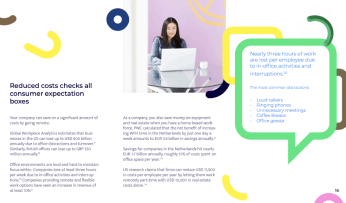There are many professional advantages to listening with the intent to understand. Also known as active listening, it’s the secret behind being a great communicator in the workplace. It also helps you grow qualitatively by improving your personal and professional relationships.
In the customer service world, listening with the intent to understand can make you a premium customer support representative (CSR) in a league apart from the rest. Promotions, bonuses, and kudos are all on your horizon when you know and practise the difference between listening to respond vs listening to understand, especially when handling irate customers.
But what differentiates listening with intent to understand apart from ordinary listening?
Listening with intent to understand explained
Consider the two phrases: listening to respond vs listening to understand, and then think of how they can play out in your interpersonal communication.
What does the phrase first suggest? Listening to respond indicates that the act of listening is just a ruse. You’re not listening but waiting until the other person stops talking so you can have your say.
However, the second part of listening to respond vs listening to understand is very different. Listening with the intent to understand means you’re paying attention not to voice your own thoughts but to understand someone else’s point of view.
Being a good communicator is about how well you’re able to listen. A good listener wants to hear what the other party is saying, so their response has focus and purpose. A response that isn’t just empathising, comforting, or learning more about a situation but also potentially resolving conflict.
Only when you pay attention to someone else’s grievance can you come a step closer to resolving it.

The four types of listening
While being a good listener matters a lot in tense or emotionally charged situations, there are four kinds of effective listening we all practice in our day to day lives.
- To appreciate
This sort of listening takes place when you’re absorbed in hearing something for the purpose of enjoyment. Your appreciation for the sounds you hear is a large part of why you’re paying attention. For example, listening to music you love or enjoying the sound of bird calls in a forest.
- To learn
Listening to learn occurs when the purpose of your attention is to educate yourself on something. You actively ingest what’s being said with an attitude of acceptance to enhance your knowledge. For example, when you listen to a podcast or attend a lecture.
- To evaluate
Listening with critical intent is about engaging with what you hear so that you can form an intellectual critique or opinion. This kind of listening comes into play when you’re debating a topic, criticising the news, or listening to a sales pitch.
- To empathise
This kind of active listening helps you understand and relate to someone else’s experience. Empathic listening allows you to comfort another person because, in the act of listening, you open yourself up to their emotions and understand how they might be feeling.
Why active listening skills matter in customer service

The majority of your work in customer service is going to be active listening. That’s how you can look after customers successfully, day after day.
The very idea of helping a stranger overcome a problem involves being a good listener first. So if you want to solve customer issues quickly and accurately, you have to understand their issues by actively listening to all aspects of their complaint.
On the customer side, people can always tell—from your display of empathy and active listening—whether your support effort is genuine and respectful or not. But why does this matter?
Leading industry research points to a powerful impact of frontline emotional intelligence on consumer-buying behaviour and business bottom lines.
McKinsey reports that over 85% of customers increased their purchases with a brand after a positive service experience, whereas at least 70% reduced their business after a negative one.
Empathetic listening in customer support greatly impacts the customer-brand relationship. As a CSR, you play the deciding role in how that relationship fares — with your ability to be a good listener.
5 do’s on how to become a better listener
The good news is, even though less than two per cent of us receive any formal training in strengthening our listening skills, it’s something you can excel at with practice. Here are a few ways to become a better communicator by practising the art of listening with the intent to understand.
1) 👀 Make eye contact

When you look someone in the eyes as they speak, you’re reassuring them through assertive nonverbal communication that they have your full attention. This is why young children often grab their parents’ faces and pull them towards their own while talking to ensure they’re listening.
Looking directly at someone also lets you register their facial expression and read a corresponding mood. After all, as the ancient adage goes, ‘the eyes are windows to the soul.’
2) 🧍🏻♀️ Use attentive body language
Always make sure you’re facing the person speaking to you by turning towards them with your whole body. Uncross your arms, lean forward and display open and receptive body language.
Human communication, like with all mammals, isn’t just in our language and tone of voice. It’s deeply rooted in the ways we communicate nonverbally as well. Attentive body language is the best way to show you’re listening.
3) 🗣️ Summarise what you’ve heard
While you don’t have to repeat everything said, paraphrasing the speaker’s concerns is an excellent way to show you aren’t listening to respond vs listening to understand with genuine interest.
Summarising their views demonstrates you weren’t just hearing them for outward appearance.
4) 🧐 Ask open-ended questions
There’s no better way to learn than by asking clarifying questions. It’s a quick and straightforward technique to become an effective communicator.
People often need a little help voicing their concerns, and asking open-ended questions can nudge them to express themselves better and share what’s on their mind.
5) 🧘🏻♂️ Listen with patience
Finally, strengthen your communication skills and become an active listener by cultivating patience. Stay quiet and wait for people to express themselves fully, even if they’re repeating themselves.
Being patient means never making the other person feel like they need to hurry up or you’ll lose interest. Respect their opinion by listening with patience.
5 don’ts when you’re practising active listening

Before entering any dialogue, remind yourself the purpose is to have a conversation, not a debate. Then, ask yourself whether you can accept someone else’s interpretation of an experience as true because this is crucial.
And just like there are some handy do’s to help you practise listening with intent to understand, there are a few don’ts too. The more you practise avoiding them, the better you’ll get at listening actively.
1) ❌ Don’t interrupt
It doesn’t matter how eager you are to make your point; nobody likes to be cut off when they’re sharing their thoughts.
There’s no pressing hurry for you to cut in and say your piece. It can certainly wait till the other person has finished talking — anything else is just rude.
2) ❌ Don’t be distracted
Multitasking when someone’s talking isn’t the best way to actively listen. Scrolling through social media, checking your phone, or being busy with other tasks gives the impression you’re not that invested in the conversation.
To be a good listener, don’t be distracted or preoccupied with other chores. Gift the person with your undivided attention.
3) ❌ Don’t assume
The art of listening isn’t about making assumptions. Never presume to know what the other person is about to say, how they might feel, or what they’re thinking.
Keep an open mind and don’t cloud the conversation with your mental projections or expectations. You’re more likely to learn more when you assume nothing.
4) ❌ Don’t judge
As an extension of keeping an open mind when listening with intent, avoid judging the other person in any way.
Aim to make every conversation a safe space for people, so they can share what’s in their hearts and minds without feeling criticised for it.
5) ❌ Don’t advise
Finally, even if it feels like the most natural thing to do, giving advice is a good idea only when you’re asked for it.
If your advice hasn’t been sought out or requested, don’t give it. It may come across as condescending, unwelcome, and even offensive.
The benefits of active listening:

When you practise listening with intent to understand, you can build stronger connections with the people around you, from friends and family to your colleagues and managers at work too. Active listening helps you with:
→ 👌🏼 Improved communication skills
Being a good listener affects your communication because any conversation is a two-way street. If you can’t listen well, what you say later might miss addressing the other person’s points, obstructing the whole purpose of your mutual dialogue.
→ 💪🏼 Refined problem solving
Listening to respond vs listening to understand is the difference between missing an opportunity to solve an issue vs taking the opportunity to solve an issue. Careful listening can help you get to the root of the problem faster and find ways to address it.
→ 🤝🏼 Increased conflict resolution skills
Drowning out someone else’s voice while rehashing your point isn’t the basis for successful diplomatic negotiation. Hearing them out and addressing their concerns is. This can only come from listening with intent to understand.
→ 🙏🏻 Better workplace collaboration
Communication mishaps can have severe consequences at work, especially when teamwork and instructions are involved. Unfortunately, workplace margins for error are low, so to avoid misunderstandings and confusion affecting your workflow, cultivate active listening. That way, you’re always on the same page that your team and bosses need you to be.
→ 🙌🏼 Stronger relationships
When your family, friends, partner, and colleagues see you as someone they can safely talk to and feel understood, you create a much stronger circle of trust. It enriches how you communicate with each other and solve problems together instead of one vs the other. It also helps you forge richer connections at work and home.
What to say and what not to say:

Sometimes, it’s all in how you say something. So to get you started with becoming a better communicator with effective listening skills, here’s a handy list of phrases to use and phrases to avoid when practising the active listening techniques we’ve shared.
Phrases to use for active listening:
“Please tell me more; I’m here to listen.”
“If I understand you correctly, what you’re saying is….”
“I want to know how you feel about this.”
“What can I do to make this better for you?”
“Thank you for sharing your feelings with me.”
Phrases to avoid as judgmental listening:
“I have no idea why you’d do such a thing.”
“I can’t believe you said that.”
“You’re not making any sense.”
“You’re wrong, and I don’t agree.”
“There’s no way I can help you here.”
Listen up

According to the International Learning Association, 85% of what we humans know is through listening; yet humanity generally is distracted, preoccupied, and forgetful about 75% of the time. This is because very few of us have mindfully developed our listening skills.
But imagine the possibilities if you worked to improve your active listening techniques.
Cultivating good listening habits can dramatically increase your knowledge and your ability to lead a richer, more aware, and insightful life while forging deeper connections with the people around you.
All it takes is a little practice with mindful listening, and you’ll notice the profound impact it has on the dynamics of your interaction with the world surrounding you.
Interested in practising some of the active listening techniques we’ve mentioned with a work-from-home customer service job?
Join us at Cocoroco to see how the power of active listening can unlock a new world of professional career growth for you. Register for free on our platform and browse remote customer support jobs today.





